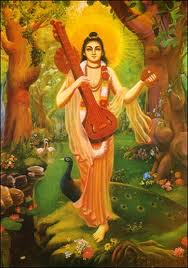NARADA PURANA |
|
 |
Shiva Darshan- Pati, Pashu, Paasha and Prapti Maharshi Sanatkumara described ‘Bhaagavata Tantra’ to Brahmarshi Narada to realise the Supreme Energy named Bhagavan through the route of ‘Shiva Darshana’. In the context of Shaiva Maha Tantra, there are three ‘Padaarthas’ (Elements) viz. Pashupati, Pashu and Paasha.The ‘Sadhanas’(tools) are four-folded viz.Vidya (Learning), Kriya (Action),Yoga and Charcha (Deliberation). Till such time that human beings are unable to shed ignorance and illusion, they continue to be called ‘Pashus’or Animals with the instincts of ‘Pashutwa’which is tantamount to ‘Daitya Bhava’or of devilish features. |
The word ‘Paasha’ denotes ‘bandhana’ or chains /shackles. These are of five types, viz. ‘Malaja’, ‘Karmaja’, ‘Maayeya’ or Mayaajanya, ‘Tirodhana Shaktija’ and ‘Binduja’. Malaja and Karmaja Paashas are due to dormant forces hiding the natural inclinations or Swabhaavika tendencies. The Mayeya bandhanas are due to the illusory forces which cover up the Truth of ‘Sat-Chit- Ananda’and suppressing the awareness of realities and highligting temporary attractions of woman, wine, wealth. The Tirodhana Shaktija Paasha lacks the power of reversal (Rodhaka Shakti) when human beings tend to ignore the distinction of Human Body and Atma or Inner Consciousness. Finally, ‘Binduja Paasha’ denotes the full awareness of the magnificence of Sat- Chit- Ananda Swarupa. Pashus are of three types viz. ‘Vigynaakala’, ‘Pralayaakala’ and ‘Sakala’. The Vigyanakala Pashu is tied with Paashas full of ‘Mala’ or dirt / filth; Pralayaakala Pashu is tied with the chains of Mala and ‘Maya’ (Illusion) also and Sakala or Sarva Pashu is tied with the chains of Mala, Maya and Karma (Deeds). When a person recognises the Swarupa of Bhagavan and practises japa, dhyana and Sanyas or even through regular life of ‘Samsara’ (family life) and reduces the worldly pulls and pressures, excepting however the normal ‘bandhanas’or shackles called ‘Anava Mala’, then that person is stated to possess ‘Vignaana kala’. When the person controls the body and mind, but still possesses the Karmaja mala and Maya-held mala or ‘Maayeya kala’, then the person is stated to possess Pralayaakala. As the person whose ‘Jeevatma’ is rid of Anava mala, Mayeya mala and karmaja mala or Pashas, then the person is stated as ‘Sakala’.Now, Vigyanakala Pashus are of two categories, viz. ‘Samaapta Kalusha (blemish) and ‘Asamaapta Kalusha’; when a Jeevatma continues to perform Karmas (deeds), then to the extent that Karma carries ‘mala’, that becomes Asamaapta Kalusha. But that person leaves off all Karmas, then that Jeeva is stated to possess Samapta kalusha.Such person reaches the status of ‘Vidyeshwara’ of eight types: Ananthaschaiva sukshmascha tathaiva cha Shivottamah, Ekanetrastathaivaika Rudraschaapi Trimurthakah/ Shri Kanthascha shikhandi cha proktaa Vidveshwara imey ( Ananta, Sukshma, Shivottama, Eka Netra, Eka Rudra, Tri Murthi, Shri Kantha and Shikhandi). Asamaapti Kalusha is he whose stock of blemishes is still unfinished; the Parameswara Mantra has to be instructed to him for the purpose. ‘Pralayaakala pashu’has two formats, viz. pakka paashadwaya and apakka -paashadwaya; as a Jeevatma sheds ‘Mala’, ‘Karma’ and ‘Maya’, then the ‘Pashas’ get weakened, then the Jeeva becomes qualified for ‘Diksha’, which is the ‘Sadhana’ or the facilitator of Shivatva. The ever merciful ‘Parameshwara’ then enters the Physique of a Guru and gives the ‘Diksha’ (Apprenticeship) to practise the seven ‘Sadhanaas’viz. ‘Kalaa’, ‘Kaala’, ‘Niyati’, ‘Vidya’, ‘Raaga’, Prakriti and ‘Guna’ along with other Tatwas vix. Pancha Bhutas or Five Elements of Earth, Water, Fire, Wind and Sky; Mana (Mind), Buddhi (Internal Feelings) and ‘Ahankar’ (Ego); Ten Indriyas (Physical Limbs); ‘Pancha Tanmatras’or Five Sound, Form, Taste, Smell and Touch, five ‘Antahkaranas’ and Five Shabdas. The Mantra- Diksha for the demolition of the ‘Bandhanas’would thus constitute steps forward to Shiva Darshana. |
|
| Narada Purana Home | Next: Explanation of Mantras, Matrika Nyaasas and Deva Puja Vidhi |
Back to the News Page